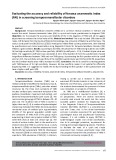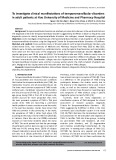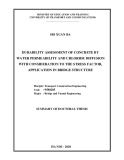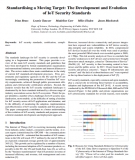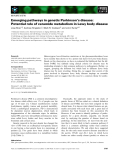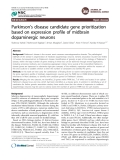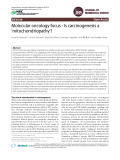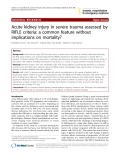
Common Criteria
-
Temporomandibular disorders (TMD) are a common medical condition in Vietnam and around the world. Fonseca Anamnestic Index (FAI) is a quick and simple questionnaire to diagnose TMD. Objectives: (1) To evaluate the accuracy and reliability of FAI in the diagnosis of TMD and (2) to suggest adjustments to enhance the clinical value of FAI.
 8p
8p  viharuno
viharuno
 03-01-2025
03-01-2025
 2
2
 2
2
 Download
Download
-
Temporomandibular disorders are relatively common disturbances in the world and Vietnam. The Diagnostic Criteria for Temporomandibular Disorders suggested by Schiffman in 2014 is a frequently used diagnostic system to classify temporomandibular disorders into subtypes, toward therapeutics purposes. Objectives: (1) To investigate clinical features of temporomandibular disorders in adult patients. (2) To classify temporomandibular disorders using the Diagnostic Criteria for Temporomandibular Disorders of Schiffman.
 6p
6p  viuchiha
viuchiha
 03-01-2025
03-01-2025
 2
2
 2
2
 Download
Download
-
Determine the coefficient of water permeability, waterproofing marks, chloride ion diffusion coefficients of some types of concrete commonly used in bridge construction subjected to pre-compressive and direct-compression loads. Develop a predictive model for life expectancy using reinforced concrete bridges taking into consideration the effect of the load according to the criteria of initial corrosion of reinforcement in concrete. Application of life expectancy for the structure of reinforced concrete bridges.
 27p
27p  kequaidan7
kequaidan7
 01-09-2020
01-09-2020
 30
30
 2
2
 Download
Download
-
Architecture of an ISO/IEC 17025 Quality Management System (QMS) for IT Security
Evaluation Labs: RASIC and Processes, General structure of the QMS documentation, Setting-up, Operating and Maintaining the QMS.
Reference: IoT security standards
 9p
9p  tradaviahe12
tradaviahe12
 23-04-2019
23-04-2019
 2507
2507
 2
2
 Download
Download
-
Heterozygous loss-of-function mutations at the glucosecerebrosidase locus have recently been shown to be a potent risk factor for Lewy body disease. Based on this observation, we have re-evaluated the likelihood that the dif-ferent PARK loci (defined using clinical criteria for disease) may be misleading attempts to find common pathways to pathogenesis.
 7p
7p  vinaphone15
vinaphone15
 28-02-2013
28-02-2013
 53
53
 3
3
 Download
Download
-
Parkinson’s disease is the second most common neurodegenerative disorder. The pathological hallmark of the disease is degeneration of midbrain dopaminergic neurons. Genetic association studies have linked 13 human chromosomal loci to Parkinson’s disease. Identification of gene(s), as part of the etiology of Parkinson’s disease, within the large number of genes residing in these loci can be achieved through several approaches, including screening methods, and considering appropriate criteria.
 5p
5p  toshiba23
toshiba23
 18-11-2011
18-11-2011
 59
59
 4
4
 Download
Download
-
Abstract Mitochondria are sub-cellular organelles that produce adenosine triphosphate (ATP) through oxidative phosphorylation (OXPHOS). As suggested over 70 years ago by Otto Warburg and recently confirmed with molecular techniques, alterations in respiratory activity and in mitochondrial DNA (mtDNA) appear to be common features of malignant cells. Somatic mtDNA mutations have been reported in many types of cancer cells, and some reports document the prevalence of inherited mitochondrial DNA polymorphisms in cancer patients.
 7p
7p  toshiba23
toshiba23
 18-11-2011
18-11-2011
 60
60
 4
4
 Download
Download
-
Tuyển tập các báo cáo nghiên cứu về y học được đăng trên tạp chí y học quốc tế cung cấp cho các bạn kiến thức về ngành y đề tài: Acute kidney injury in severe trauma assessed by RIFLE criteria: a common feature without implications on mortality?
 6p
6p  toshiba18
toshiba18
 31-10-2011
31-10-2011
 45
45
 2
2
 Download
Download
-
Stability Issues in RNN Architectures Perspective The focus of this chapter is on stability and convergence of relaxation realised through NARMA recurrent neural networks. Unlike other commonly used approaches, which mostly exploit Lyapunov stability theory, the main mathematical tool employed in this analysis is the contraction mapping theorem (CMT), together with the fixed point iteration (FPI) technique. This enables derivation of the asymptotic stability (AS) and global asymptotic stability (GAS) criteria for neural relaxive systems.
 19p
19p  doroxon
doroxon
 12-08-2010
12-08-2010
 108
108
 9
9
 Download
Download
CHỦ ĐỀ BẠN MUỐN TÌM









